Non-stationary Transformers: Exploring the Stationarity in Time Series Forecasting (NeurIPS 2022)
https://github.com/thuml/Nonstationary_Transformers.
Contents
- Abstract
- Introduction
- Related Works
- Deep Models for TSF
- Stationarization for TSF
- Non-stationary Transformers
- Series Stantionarization
- De-stationary Attention
- Experiments
- Experimental Setups
- Main Results
- Ablation Study
Abstract
Previous studies : use stationarization to attenuate the non-stationarity of TS
\(\rightarrow\) can be less instructive for real-world TS
Non-stationary Transformers
Two interdependent modules:
- (1) Series Stationarization
- unifies the statistics of each input
- converts the output with restored statistics
- (2) De-stationary Attention
- to address over-stationarization problem
- use attention to recover the intrinsic non-stationary information into temporal dependencies
1. Introduction
Non-stationarity of data
- continuous change of statistical properties and joint distribution over time ( makes it less predictable [6, 14] )
- generally acknowledged to pre-process the time series by stationarization [24, 27, 15]
However, non-stationarity is the inherent property
\(\rightarrow\) also good guidance for discovering temporal dependencies
Example) Figure 1
-
( Figure 1 (a) ) Transformers can capture distinct temporal dependencies from different series
-
( Figure 1 (b) ) Transformers trained on the stationarized series tend to generate indistinguishable attentions
\(\rightarrow\) over-stationarization problem
- unexpected side-effect … makes Transformers fail to capture eventful temporal dependencies
Key question:
- (1) how to attenuate TS non-stationarity towards better predictability
- (2) mitigate the over-stationarization problem?
Proposal:
- explore the effect of stationarization in TSF
- propose Non-stationary Transformers
Non-stationary Transformers
two interdependent modules:
- (1) Series Stationarization
- to increase the predictability of nonstationary series
- (2) De-stationary Attention
- to alleviate over-stationarization
a) Series Stationarization
- simple normalization strategy
- to unify the key statistics of each series without extra parameters
b) De-stationary Attention
- approximates the attention of unstationarized data
- compensates the intrinsic non-stationarity of raw series
2. Related Works
(1) Deep Models for TSF
- pass
(2) Stationarization for TSF
Adaptive Norm [24]
- applies z-score normalization for each series fragment by global statistics
DAIN [27]
- employs a nonlinear NN to adaptively stationarize TS
RevIN [15]
- two-stage instance normalization
Non-stationary Transformer
- directly stationarizing TS will damage the model’s capability of modeling specific temporal dependency.
- in addition to the (1) stationarization, further develops (2) De-stationary Attention to bring the intrinsic non-stationarity of the raw series back to attention.
3. Non-stationary Transformers
(1) Series Stationarization
Straightforward but effective design to wrap Transformers as the base model without extra parameters
2 corresponding operations:
- (1) Normalization module
- (2) De-normalization module
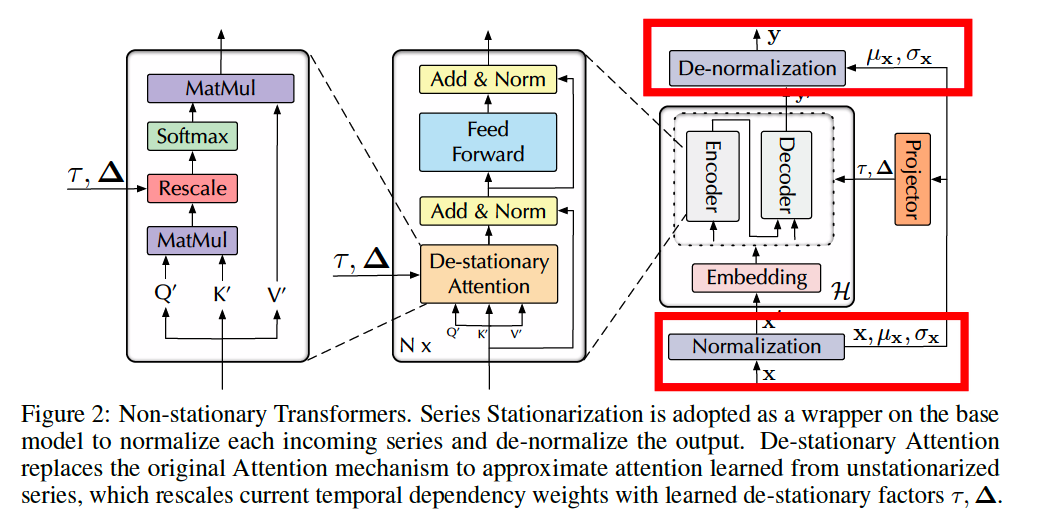
(2) De-stationary Attention
Non-stationarity of the original TS cannot be fully recovered only by Denormalization!
De-stationary Attention mechanism
- approximate the attention that is obtained without stationarization
- discover the particular temporal dependencies from original non-stationary TS
Self-Attention: \(\operatorname{Attn}(\mathbf{Q}, \mathbf{K}, \mathbf{V})=\operatorname{Softmax}\left(\frac{\mathbf{Q K}^{\top}}{\sqrt{d_k}}\right) \mathbf{V}\).
Bring the vanished non-stationary information back to its calculation
-
approximate the
- positive scaling scalar \(\tau=\sigma_{\mathbf{x}}^2 \in \mathbb{R}^{+}\)
- shifting vector \(\boldsymbol{\Delta}=\mathbf{K} \mu_{\mathbf{Q}} \in \mathbb{R}^{S \times 1}\),
which are defined as de-stationary factors.
-
try to learn de-stationary factors directly from the statistics of unstationarized \(\mathbf{x}, \mathbf{Q}\) and \(\mathbf{K}\) by MLP
\(\log \tau=\operatorname{MLP}\left(\sigma_{\mathbf{x}}, \mathbf{x}\right)\).
\(\boldsymbol{\Delta}=\operatorname{MLP}\left(\mu_{\mathbf{x}}, \mathbf{x}\right)\). \(\operatorname{Attn}\left(\mathbf{Q}^{\prime}, \mathbf{K}^{\prime}, \mathbf{V}^{\prime}, \tau, \boldsymbol{\Delta}\right)=\operatorname{Softmax}\left(\frac{\tau \mathbf{Q}^{\prime} \mathbf{K}^{\prime}+\mathbf{1} \boldsymbol{\Delta}^{\top}}{\sqrt{d_k}}\right) \mathbf{V}^{\prime}\).
4. Experiments
(1) Experimental Setups
a) Datasets
- Electricity
- ETT datasets
- IExchange
- ILI
- Traffic
- Weather
b) Degree of stationarity
Augmented Dick-Fuller (ADF) test statistic
- small value = high stationarity

c) Baselines
- pass
(2) Main Results
a) Forecasting
MTS Forecasting
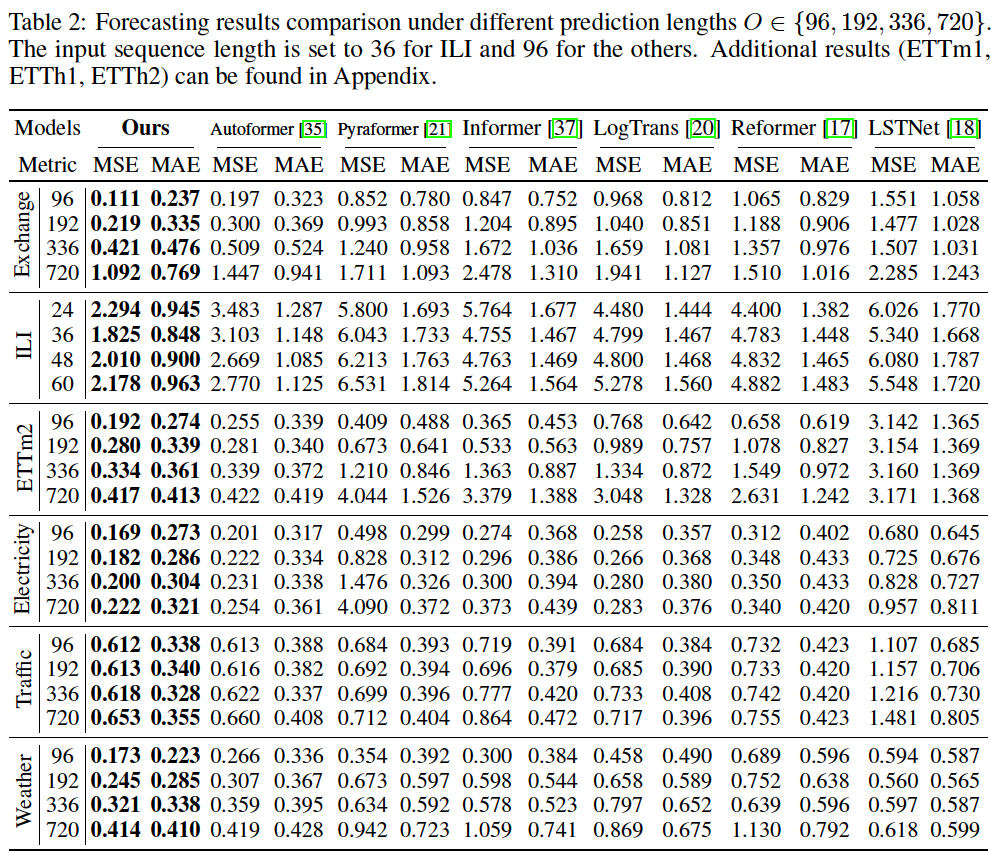
UTS Forecasting
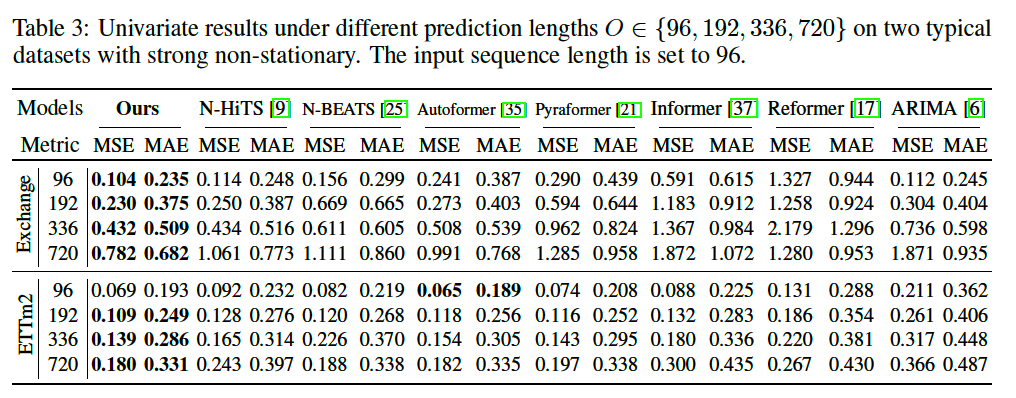
b) Framework Generality
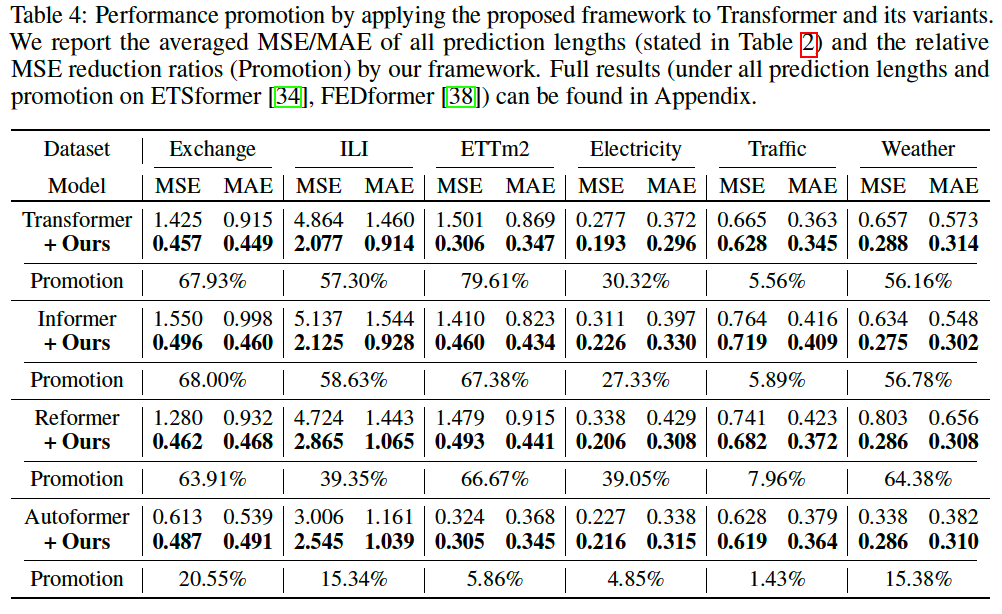
Conclusion: Non-stationary Transformer is an effective and lightweight framework that can be widely applied to Transformer-based models and enhances their non-stationary predictability
(3) Ablation Study
a) Quality evaluation
Dataset: ETTm2
Models:
- vanilla Transformer
- Transformer with only Series Stationarization
- Non-stationary Transformer

b) Quantitative performance
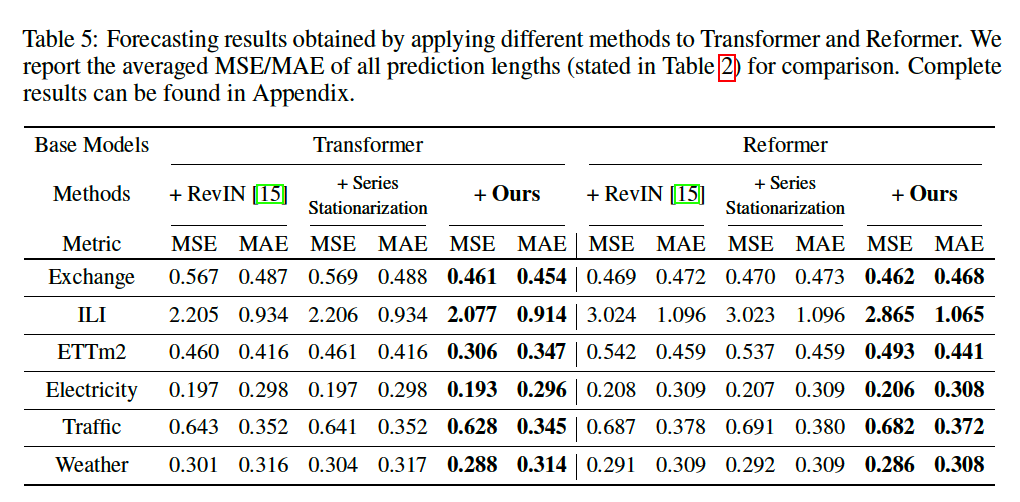
(3) Model Analysis
a) Over-stationarization problem
Transformers with ….
- v1) Transformer + Ours ( = Non-stationary Transformer )
- v2) Transformer + RevIN
- v3) Transformer + Series Stationarization
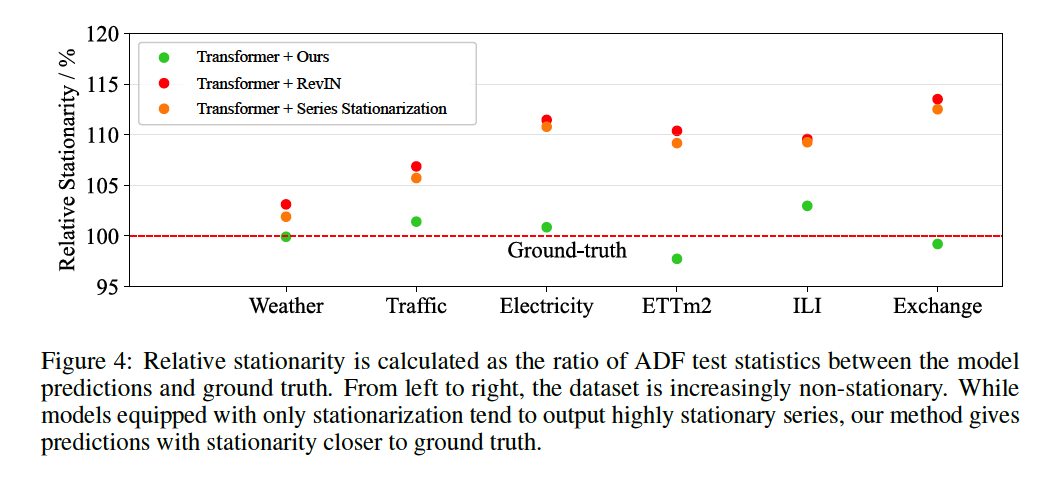
Result
- v2 & v3) tend to output series with unexpected high degree of stationarity
